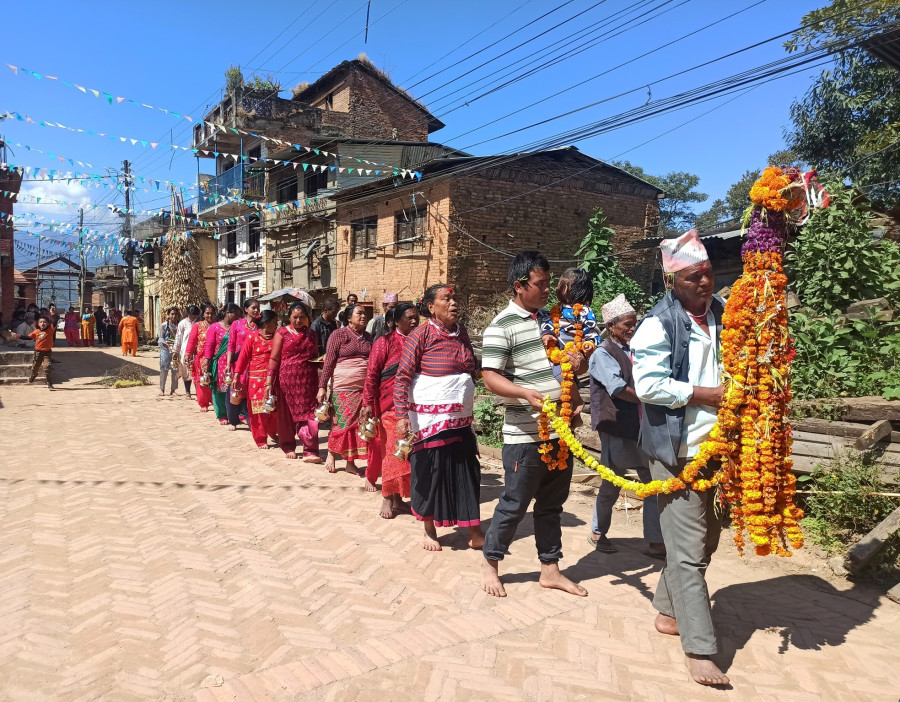Columns
Pyangaon revisited: Tradition and continuity
Its rural character still differs markedly from the nearby cities of Kathmandu and Lalitpur.
Gérard Toffin
The anthropology of change and modernity is a multifaceted issue. How has the small single-subcaste Newar agricultural village that I studied in the early 1970s been affected by the major transformations that Nepal has endured over the last 50 years? In November 2022, I made several visits to the place where I conducted my initial fieldwork, Pyangaon, 17 km south of Kathmandu. A number of young boys immediately welcomed me, repeating that they were the sons of so-and-so with whom I was on familiar terms. “We need your help to preserve our original culture”, they all insisted. It was not the first time I had been back to this locality; yet such visits rapidly became the main focus of my recent trip to Nepal.
Pyangaon (in Nepāl bhāṣā or Newari: Svãgu), populated by a particular agricultural subcaste, has changed considerably. With regards housing, bricks have often been replaced by cement, and pitched roofs by flat terraces. The ceilings are higher and the carved wooden windows have disappeared. In addition, new houses have been built around the pond at the entrance to the village and some of them are rented out to Tamang and Hindu Bahun-Chhetri groups. The village appears to be cleaner than 50 years ago. Buffalo husbandry, so essential in the past for the sale of milk to faraway places, has been abandoned. However, the only street in the locality, still flanked on both sides by high wooden stakes to dry maize and by two compact rows of terrace houses, is still the same. A new arched concrete gate at the entrance to the village reinforces the demarcation between Pyangaon and the outside, and sustains the sensation that one is entering a reclusive, secluded, community.
The standard of living and people’s everyday clothes have considerably improved, as has their lifestyle. In most houses, there are TVs and modern furniture (in 1970, there was no electricity). The village has entered the digital world of the World Wide Web: Young people have a mobile phone, an Internet connection and surf Facebook and Tik-Tok. Furthermore, Pyangaon/Svãgu, which has never been a self-sufficient locality, is increasingly dependent today on a market economy. The use of old horizontal weaving looms, where the woman operating it sits on the floor, has practically been abandoned. Ready-made garments are now worn and are bought on the market. Farming (irrigated rice and non-irrigated crops such as maize, mustard and wheat) still remains one of the inhabitants' main occupations, but often only on a part-time basis. Thanks to schooling, more and more young educated boys (and a few girls) work as clerks and accountants in neighbouring towns. It takes them only 30–45 minutes in the morning to go to work by motorbike and the same amount of time in the evening to return to Pyangaon. Other men are employed here and there in the building sector. Some fields, especially those situated furthest away from the village, have been sold at a very high price. What is more, young people are trying to revive the craft of making bamboo containers, pyāṅg (or dyāṃcā, hāpā) (hence the Nepali name for the village), once used to measure grain and to store varieties of spices.
The population has more than doubled (about 1,400 persons at present, instead of 550 in 1970, yet the village has retained its unique identity. Its rural character still differs markedly from the nearby cities of Kathmandu and Lalitpur and its specific Newari dialect, bhāṣika, is still spoken in the locality. From a sociological viewpoint, the division of the village into two factions subsequent to a debatable case of intercaste marriage with an outsider in the 1940s is no longer discernible. In fact, nowadays, intercaste marriage with girls from outside the locality is increasingly challenging the traditional mode of marrying endogamously. “Now, everyone marries girls from outside”, says teenager Sumina Maharajan. The gap between the younger (kvakāli) and older (thakāli, or thakāri in the local language) generation is therefore widening. However, sociologically, the holistic features of Pyangaon still prevail. Members of the community (Svãgumis, “the people of Svãgu”, in the local language) are still encapsulated within an all-encompassing social order. They have to accept binding communal rules and are submitted to a strict organisation of labour, an annual calendar of festivals and ceremonies, as well to a large number of obligations towards their relatives.
These constraints do not basically differ from what I observed 50 years ago. If marriage is contracted with somebody from outside the village, even with a girl of higher caste, men retain their membership within the local group, but their sons are excluded from the main socioreligious events. By and large, patrilineal kinship remains one of the roots of local society. Nonetheless, young women have now formed voluntary groups, mahilā samūha, in order to be more independent, to manage their own savings, or to heat the inner bark of bamboo in the fire for making pyāṅg containers. On the whole, they try to impose their own vision of the future—an outcome of the recent mahilā feminist movement in the country. In matters of political orientations, wood sculptor Narendra Maharjan, one of my old friends from the village, who recently converted to Christianity under the influence of a local Jehovah’s Witness church, informed me that in November 2022, during the general elections, Svãgumis cast votes in favor of a wide range of political parties (not just a single one): Communist, Congress, and others. “Options even vary within a family”, Narendra told me.
Religion, which is basically ritualistic among Newar farmers or former farmers, is still a pillar of society. A number of rituals and ceremonial observances, mostly of a Hindu character, structure social life. Pyangaon, for instance, still celebrates a major eleven-day-long joint festival (mū yāḥ) at the end of the rainy season; the five guthi (locally known as gvahã), socio-religious groups rooted in kinship units, take part in it. The old theatrical play kuṃ pyākhã (or rājā-rāni nāc) staged during the festival has been revived with a modern twist. In the nearby Jyapu/Mallakar village of Theco, I was able to join Navadurga dances which in 2022 took a special dimension (it was its Barha Barsa event) with more deities participating in the masked dances. On that occasion, most of the inhabitants of Pyangaon have to offer flowers, rice, and money to the dancers who embody the divinities. Thanks to my good relations with one of the persons in charge of the dance, Prasant Mallakar, I was able to visit the inside of the new small temple dedicated to these nine Durgās—a temple that was recently rebuilt after being destroyed during the 2015 earthquake. For the rest of the year, the masks of the deities are housed here. Outside, the remains of the large hut (balcā) that was used for celebrating important rituals every twelve years were still visible.
Two conclusions can be drawn from this summary report. 1. Altogether, three forms of attachment, both secular and religious, continue to prevail in Pyangaon: To basic local patrilineal kinship units, to the small single-subcaste village and, lastly, to the Newar ethnic group. This triadic configuration roughly defines the Svãgumi system of belonging, both past and present. 2. The report also shows that even if macro political, demographic and economic data on transformations are of major import, the findings of local inside ethnological micro-studies are also crucial and sometimes provide a more comprehensive viewpoint of the sociocultural facts.




 8.12°C Kathmandu
8.12°C Kathmandu















